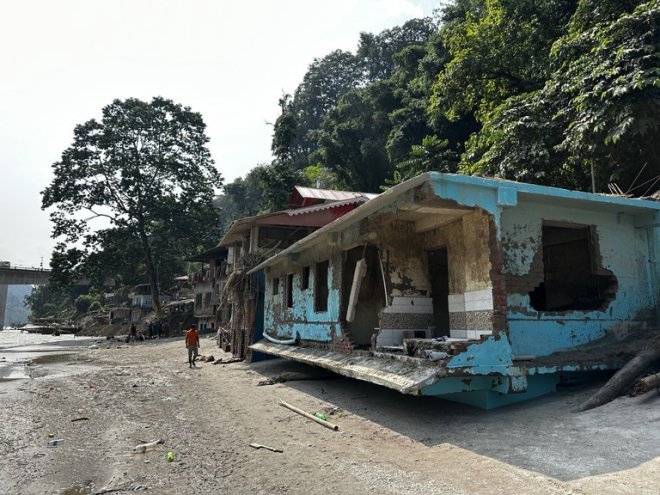ASEAN’s Myanmar peace plan has been ineffective, bloc chair Indonesia acknowledges
The president of 2023 ASEAN chair Indonesia warned the Burmese military on Thursday that human rights violations “cannot be tolerated,” even as he acknowledged the bloc has made no progress in implementing its Myanmar peace plan.Still, as they wrapped up their two-day summit in Indonesia, leaders of the Association of Southeast Asian Nations expressed their “deep concern” about the escalation of violence in member-state Myanmar, but insisted on sticking to a peace plan that critics have panned as ineffective.
“Violations of humanitarian values cannot be tolerated,” President Joko “Jokowi” Widodo said at a press conference following the end of the summit in Labuan Bajo, a seaside town on Flores island.
He stressed the need to engage all parties in Myanmar, saying “ASEAN’s credibility is at stake.”
Myanmar, which was not represented at the summit after the junta was barred from sending political representatives, has been in turmoil since the military overthrew an elected government in February 2021.
The Burmese military has ignored a five-point consensus it agreed to with ASEAN in April 2021, one of whose main points was an end to violence. Its forces have also killed more than 3,400 people since the generals seized power.
“I must speak candidly. On the implementation of the 5PC [Five-Point Consensus], there has not been significant progress. Therefore, ASEAN unity is required to decide on the next steps,” Jokowi told his Southeast Asian counterparts on Thursday, according to a copy of his speech.
Nevertheless, ASEAN leaders reaffirmed their support for the five-point plan, a statement by the ASEAN chair said at the end of the summit.
“We discussed the development in Myanmar and reiterated our unified position that the Five-Point Consensus remains our main reference,” the statement said.
“We supported the chair’s continued engagement with all stakeholders in Myanmar to find a peaceful and durable solution that is Myanmar-owned and Myanmar-led, to create a conducive environment for facilitating an inclusive national dialogue.”
Jokowi calls for ASEAN unity
Meanwhile, Indonesia as ASEAN chair was ready to hold talks with all parties in Myanmar “for humanitarian reasons,” Jokowi said at the press conference.
“Engagement does not mean recognition,” he said.
He also warned against any external interference in ASEAN.
“Without unity, it will be easy for others to break ASEAN. There should be no party inside or outside ASEAN that benefits from the conflict in Myanmar,” Jokowi said.
“Violence must be stopped and people must be protected.”
The Myanmar junta has cracked down on mass protests, killed more than 3,000 people and arrested thousands more, according to human rights groups. The United Nations said more than 1.8 million people had been forced to flee their homes in Myanmar because of violence since the coup.
The crisis has strained ASEAN’s unity and credibility. The regional bloc has struggled to find a common stance and exert influence over the junta.
Many regional observers and analysts, as well as the previous foreign minister of Malaysia, had said it was time to junk the consensus and devise a new plan on a deadline that included enforcement mechanisms.
Some experts say that ASEAN’s approach to Myanmar reflects its limitations as a consensus-based organization that prioritizes stability and non-interference in its members’ domestic affairs.
Others argue it still has a role to play but needs to be more assertive and creative in dealing with the junta.
“It remains relevant to unite ASEAN and prevent ASEAN countries from moving on their own, and taking actions that undermine collective efforts,” said Muhammad Waffaa Kharisma, a researcher at the Centre for Strategic and International Studies in Jakarta.
“But it is true that it needs to be evaluated for its effectiveness. It gives too much decision-making power to the military junta,” he told BenarNews. “If the military junta does not change its behavior, there is no mechanism to change that.”
Contested waterway
During the summit, the leaders also discussed some issues at the heart of territorial disputes in the South China Sea.
The chair’s statement said some ASEAN members had raised concerns about land reclamations, and damage to marine environment caused by certain activities in the sea, although no countries were named.
The South China Sea is one of the world’s busiest waterways and has an abundance of natural resources. It is home to several flashpoints involving maritime disputes over oil and gas exploration projects and fishing rights.
China claims nearly the entire sea, including waters within the exclusive economic zones of Brunei, Malaysia, the Philippines, Vietnam and Taiwan. While Indonesia does not regard itself as a party to the South China Sea dispute, Beijing claims historic rights to parts of the waterway overlapping Indonesia’s exclusive economic zone as well.
The ASEAN leaders reaffirmed “the need to enhance mutual trust and confidence, exercise self-restraint in conducting activities that would complicate or escalate disputes and affect peace and stability, and avoid actions that may further complicate the situation,” the statement said.
The statement welcomed the progress in negotiations for a code of conduct, which aims to prevent conflicts and maintain peace and stability in the South China Sea.
China and ASEAN signed a nonbinding declaration on the conduct of parties in the South China Sea in 2002, but negotiations on the code of conduct have been slow and contentious.
The two sides agreed on a single draft text in 2018, with the latest round of negotiations taking place in March in Jakarta.
On the sidelines of the summit, Jokowi invited the other leaders to sail together on a traditional wooden boat called “phinisi.”
“ASEAN is one family,” he said.
“The ties are very strong and the unity is very important to sail towards the same goal.”
Tria Dianti in Jakarta contributed to this report. BenarNews is an RFA-affiliated news service.
[圖擷取自網路,如有疑問請私訊]
|
本篇 |
不想錯過? 請追蹤FB專頁! |
| 喜歡這篇嗎?快分享吧! |
相關文章
AsianNewsCast






















